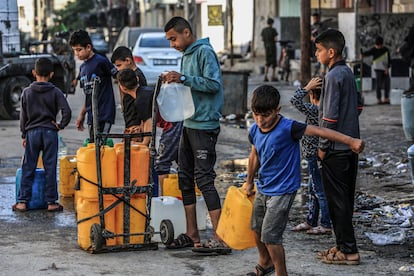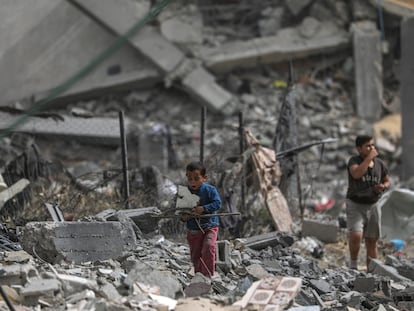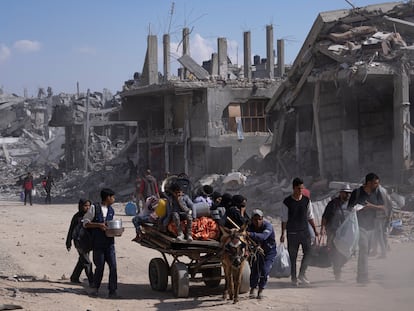Gaza hospitals coin WCNSF acronym: Wounded child, no surviving family
Save the Children aid worker Soraya Ali describes apocalyptic scenes in Rafah where starving children walk barefoot and alone, desperately searching for food and water

On my first day in Rafah, in southern Gaza, my colleague Hawa’s mother had a stroke. With no ambulance available, she was taken to a partially operational hospital. She passed away two days later. “The sorrow of this war killed her,” Hawa later told me. I arrived in Gaza with Save the Children, as part of a group of pediatricians, surgeons and aid workers to help children caught in rapidly worsening humanitarian crisis. Nothing could have prepared us for what we were about to see.
Our Palestinian colleagues, like Hawa, have doggedly served their communities despite personal hardships. Many of our staff were displaced, lost family and were personally affected by the war. Sadly, Sameh Ewida from Save the Children’s Gaza office lost his life along with his entire family in an Israeli airstrike last December.
The brutal war in the Gaza Strip has claimed over 33,000 lives, including at least 13,900 minors, as reported by the Gaza Health Ministry. Israeli airstrikes have targeted healthcare workers, teachers and humanitarian aid staff. This comes at a time when the needs are more pressing than ever.
The scenes I witnessed in Rafah in early April will stay with me forever. The small city, once home to 275,000 people before the war, has ballooned to a population of around 1.5 million, mostly women and children fleeing from points north. Drones constantly hover overhead, their persistent buzz a grim reminder of the threat faced by the innocent. The buzzing means an explosion is imminent.
I was forced to eat food the rats wouldn’t touch. Going out to look for food was just too dangerous.
The large number of children roaming the city is overwhelming, almost apocalyptic. They were barefoot, visibly malnourished, and often alone. UNICEF reported in February that at least 17,000 minors in Gaza were unaccompanied or separated from their families. The actual number is likely much higher now. Hospitals coined a bleak new acronym to identify them: WCNSF – wounded child, no surviving family.
Diseases and infections spread quickly. Healthcare professionals are hard-pressed to make formal diagnoses due to time and resource constraints. In a mobile hospital, I observed many children with rashes, some with vomiting and bloody diarrhea. “We are seeing many cases of scabies, lice and hepatitis,” said one doctor. On top of all the illness are the wounds of war. “We treated a pregnant woman with a gunshot wound to the stomach,” said another doctor.
I met a boy, about 12, pushing his younger brother in a wheelchair. The little one, visibly dirty and wearing torn clothes, was missing a leg. He is one of over 1,000 children who have lost limbs since the war started, according to UNICEF. There’s no where to go, the older boy said, as schools have been destroyed or closed since last October.
I met a boy, about 12, pushing his younger brother in a wheelchair. The little one, visibly dirty and wearing torn clothes, was missing a leg.
Children in Gaza spend their days trying to survive, hiding from bombs and endlessly seeking food and water. Reduced to playing with an old plastic bag, some ask for a soccer ball to pass the time. They endure a grim reality of malnutrition, disease and despair, if not death. It’s all too risky to go out and look for food.
“So many people have died that we don’t even have time mourn,” lamented my colleague Zainab (a pseudonym). Last week, her husband finally made it to Rafah after being trapped in the northern part of the Strip. Her 70-year-old father, who suffers from Alzheimer’s and cancer, couldn’t be evacuated and had to stay behind. “I was forced to eat food the rats wouldn’t touch. Going out to look for food was just too dangerous,” Zainab said. She narrowly escaped an Israeli attack that killed more than 100 people waiting for desperately needed food aid in northern Gaza. According to the Gaza Health Ministry, over 400 Palestinians have died and 1,300 have been injured in Israeli attacks while seeking food, medicine and other vital aid for their families.
Delivering aid in and around Gaza is extremely challenging due to ongoing restrictions. All incoming aid must be authorized by Israel, which rejects items deemed to have dual civilian and military use.
There’s no excuse for the shockingly inadequate aid reaching Gaza. More help needs to arrive much faster.
Entire trucks of humanitarian aid have been rejected under this rule for carrying items as small as a package of dates or a pair of scissors. Although some aid has reached the Strip, fuel shortages and inadequate security guarantees for humanitarian workers have made deliveries very risky.
There’s no excuse for the shockingly inadequate aid reaching Gaza. More help needs to arrive much faster. And we need an immediate and lasting ceasefire. Before October 7, around 80% of the population in the Gaza Strip relied on humanitarian assistance. Now, the need is greater than ever. Without a ceasefire and full, unrestricted access to aid, children will continue to suffer and die.
According to Save the Children, nearly 26,000 minors — just over 2% of Gaza’s child population — have been killed or injured in Gaza during six months of war. These deaths are the result of the world’s failure to protect them. The international community must urgently step up its efforts — time is running out.
The only thing that will save families in Gaza now is a permanent ceasefire. The U.N. Security Council called for a temporary ceasefire, but the window for its implementation during the Ramadan fasting period has passed without progress. More children have paid with their lives due to this inaction. We need a lasting ceasefire right now because honestly, there’s just no other option.
Children are paying the heaviest price for Israel’s relentless use of explosive weapons in densely populated areas. Every country should immediately stop supplying weapons to both sides in this war. Anything less is not just a failure, but a betrayal of humanity.
Sign up for our weekly newsletter to get more English-language news coverage from EL PAÍS USA Edition
Tu suscripción se está usando en otro dispositivo
¿Quieres añadir otro usuario a tu suscripción?
Si continúas leyendo en este dispositivo, no se podrá leer en el otro.
FlechaTu suscripción se está usando en otro dispositivo y solo puedes acceder a EL PAÍS desde un dispositivo a la vez.
Si quieres compartir tu cuenta, cambia tu suscripción a la modalidad Premium, así podrás añadir otro usuario. Cada uno accederá con su propia cuenta de email, lo que os permitirá personalizar vuestra experiencia en EL PAÍS.
¿Tienes una suscripción de empresa? Accede aquí para contratar más cuentas.
En el caso de no saber quién está usando tu cuenta, te recomendamos cambiar tu contraseña aquí.
Si decides continuar compartiendo tu cuenta, este mensaje se mostrará en tu dispositivo y en el de la otra persona que está usando tu cuenta de forma indefinida, afectando a tu experiencia de lectura. Puedes consultar aquí los términos y condiciones de la suscripción digital.
More information
Archived In
Últimas noticias
There is as much life left to discover on planet Earth as that which is already known
Dozens presumed dead, around 100 injured in fire at Swiss Alps bar during New Year’s celebration
Is porn for women different from conventional porn? We spoke to those who make it
Cartagena de Indias is sinking: What can the city do to mitigate it?
Most viewed
- Reinhard Genzel, Nobel laureate in physics: ‘One-minute videos will never give you the truth’
- David King, chemist: ‘There are scientists studying how to cool the planet; nobody should stop these experiments from happening’
- Oona Chaplin: ‘I told James Cameron that I was living in a treehouse and starting a permaculture project with a friend’
- Sinaloa Cartel war is taking its toll on Los Chapitos
- The Interoceanic Train, the Mexican alternative to the Panama Canal










































